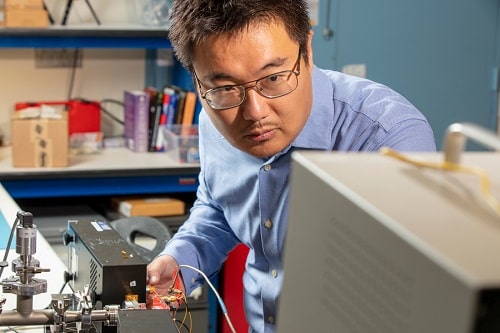The novel idea to develop next-generation electronic devices by harnessing terahertz waves can revolutionise modern communications technology

Researchers at MIT have envisaged developing a new class of microelectronic circuits having increased speeds by harnessing terahertz waves. The new semiconductors will be able to operate efficiently at very high frequencies.
The development could be highly beneficial for applications involving rapid, high-volume data transfer wireless communications, sensing and security, thus pushing wireless devices beyond 5G.
“Traditionally, terahertz has been an unexplored territory for researchers simply because, frequency-wise, it is too high for the electronics people and too low for the photonics people,” said Ruonan Han, Associate professor of Electrical Engineering and Computer Science, MIT.
The terahertz region of the electromagnetic spectrum, which lies between microwaves and infrared light, has largely baffled researchers because conventional electronic devices are too slow to manipulate terahertz waves.
However, the good thing about terahertz frequency waves is that they can move through solid surfaces and generate very precise, high-resolution images of what is inside.
Radio frequency (RF) waves can also travel through surfaces (the reason why your Wi-Fi router can be in a different room than your computer). But terahertz waves are much smaller than radio waves, so the devices that transmit and receive them can be smaller too.
To demonstrate this possibility, Ruonan Han along with Anantha Chandrakasan, dean of the School of Engineering and the Vannevar Bush Professor of Electrical Engineering and Computer Science, used a terahertz frequency identification (TFID) tag that was barely 1 square millimetre in size.
“It doesn’t need to have any external antennas, so it is essentially just a piece of silicon that is super-cheap, super-small, and can still deliver the functions that a normal RFID tag can do. Because it is so small, you could now tag pretty much any product you want and track logistics information such as the history of manufacturing, etc. We couldn’t do this before, but now it becomes a possibility,” he says.
The terahertz band could also be useful for wired communications as demonstrated by the use of ultrathin cables to transmit data between two points at a speed of 100 gigabits per second.
Application Beyond Communications
Terahertz waves have unique properties beyond their applications in communications devices. The waves can cause different molecules to rotate at exceptional speeds, thus helping to reveal a substance’s composition.
“We can make low-cost silicon chips that can ‘smell’ a gas. We’ve created a spectrometer that can simultaneously identify a large range of gas molecules with very low false alarms and high sensitivity. This is something that the other spectrum is not good at,” says Ruonan Han.
This characteristic enabled the research team to invent a molecular clock that can turn the molecular rotation rate into a highly stable electrical timing signal for navigation, communication and sensing systems. Although it functions much like an atomic clock, this silicon chip has a simpler structure and greatly reduced cost and size.
The work on terahertz waves also requires an interdisciplinary mindset for collaboration with other domains, such as chemistry and physics to explore how the technology can lead to useful new applications.
“Our goal is not only to work on the electronics, but to explore the applications that these electronics can enable, and demonstrate the feasibility of those applications,” said Ruonan Han.
“One especially important aspect of my research is that we don’t just want to deal with the terahertz spectrum, we want to make it accessible. We don’t want this to just happen inside labs, but to be used by everybody. So, you need to have very low-cost, very reliable components to be able to deliver those kinds of capabilities.”
He further adds, “We have a lot of limitations in the materials and speeds of devices that can reach those frequencies, but once you get there, a lot of amazing things happen.”






